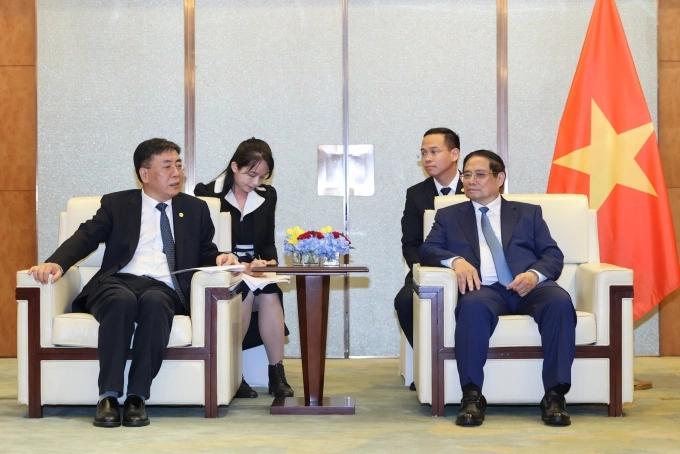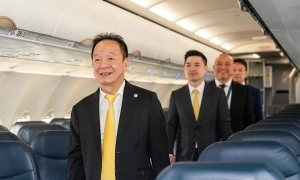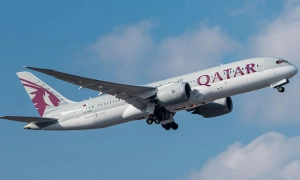According to CEO Le Hong Ha, the national flag carrier continued to sustain positive business momentum in the second quarter. Passenger volume exceeded the plan by 1.9%, while available seat kilometers surpassed targets by 2.2%. As a result, Vietnam Airlines’ revenue is estimated at VND 22.1 trillion, nearly 6% higher than planned.
The CEO said that the parent company is expected to report a profit of VND 1,000 billion, while consolidated pre-tax profit is projected at around VND 1,600 billion. Cumulatively, pre-tax consolidated profit in the first half of the year exceeded VND 5,000 billion—far surpassing pre-pandemic levels. From 2017 to 2019, the carrier’s highest annual profit only reached VND 2,500–2,600 billion.
Vietnam Airlines CEO Le Hong Ha at the annual general meeting, June 25. Photo: VNA
“International markets contributed significantly to our performance, accounting for as much as 65% of total revenue in the first half of 2025,” Mr. Ha noted. Since last year, Vietnam Airlines has launched 13 new routes, expanding its international network to 69 routes serving 37 destinations across 21 countries—the fastest pace of growth in the company’s history.
Despite this, the airline has presented shareholders with a cautious full-year business plan. For 2025, Vietnam Airlines forecasts consolidated revenue of VND 116.7 trillion, an increase of 3.5%, and profit of VND 5.55 trillion—equivalent to only 66% of last year’s performance.
Explaining the conservative outlook, Mr. Ha stressed that aviation is an extremely sensitive industry, where every factor can have an impact. He cited the recent Iran–Israel conflict, which forced Vietnam Airlines to reroute all flights between Vietnam and Europe. Each diversion adds 25 minutes per leg, driving up fuel expenses.
Conflicts have also pushed global oil prices higher. Mr. Ha noted that every USD 1 change in jet fuel price translates to an impact of USD 10 million on the airline’s annual operations. The company also faces exchange rate risks, with foreign-currency expenses typically accounting for 65% of total operating costs.
In addition, Vietnam Airlines is under pressure as both domestic and international aviation markets recover. “Average fares are trending downward after the post-pandemic growth period,” the CEO said.
Fleet development was another key focus at the annual meeting. Chairman Dang Ngoc Hoa revealed that the airline has signed a contract with suppliers for 50 narrow-body aircraft and submitted it to authorities. Deliveries are expected to begin in 2030 with 14 aircraft, followed by 18 aircraft annually from 2032 onwards.
Given the current global shortage of aircraft, Mr. Hoa described this as the best delivery schedule Vietnam Airlines could secure, though the airline had hoped for earlier allocations.
Vietnam Airlines Chairman Dang Ngoc Hoa speaking at the annual meeting, June 25. Photo: VNA
Beyond narrow-bodies, the chairman also confirmed plans to expand the wide-body fleet. Vietnam Airlines currently operates 31 wide-body aircraft, including Airbus A350s and Boeing 787s. By 2035, the airline expects to need at least 50 wide-body jets—20 to replace expiring leases and 30 to support international route expansion.
Looking ahead, Vietnam Airlines aspires to become one of the top two airlines in Southeast Asia by scale and rank among the top 10 most preferred airlines in Asia. The carrier aims to maintain its 4-star Skytrax rating while progressing toward 5-star international certification. To achieve this, the company is implementing a comprehensive restructuring plan encompassing asset and capital reorganization, investment portfolio adjustments, and governance model renewal.






